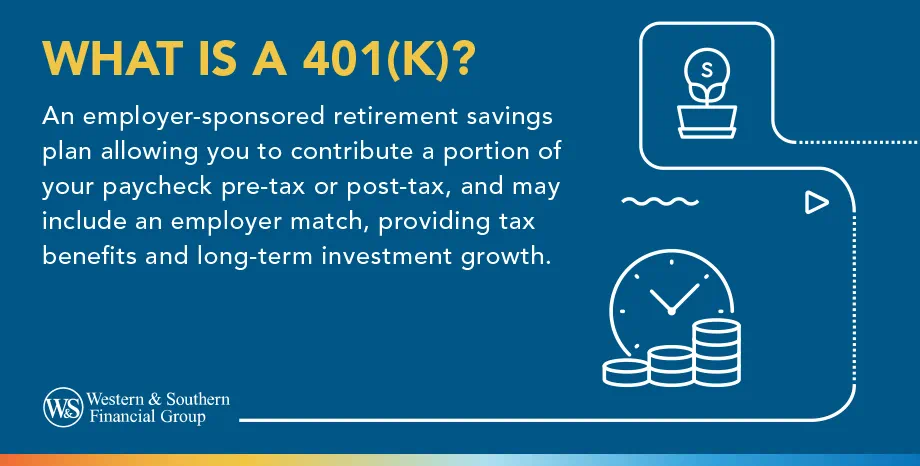

Key Takeaways
- 401(k)s are a tax-advantaged retirement savings plan offered by employers.
- There are different types of 401(k) plans, each with its own benefits and drawbacks.
- The amount you contribute to your 401(k) depends on your financial situation and retirement goals.
- You should consider increasing your contributions as you get closer to retirement.
- If your employer doesn't offer a 401(k), there are other options available to you.
One common tool for building retirement savings is a 401(k). It provides a tax-advantaged way to invest for the long term. As you move through your career, learning 401(k) basics, including how an employer-sponsored 401(k) plan works, can help you plan and pursue future financial goals. Here are the key details to know.
What Is a 401(k) & How Does It Work?
A 401(k) is an employer-sponsored retirement savings plan. With this plan, you can contribute a percentage of your salary into your account. From there, you can allocate money among the investment options the plan offers. In some cases, your employer may offer matching. That means it matches your contribution up to a certain percentage, essentially putting free money into your account.
The balance in your account may vary with market performance. Regardless, you may not owe current taxes on earnings provided you meet certain qualifications. You don't pay taxes on the money until you withdraw it in retirement (when you may be in a lower tax bracket).
Another thing to note is the annual contribution limit the IRS sets.
Maximum 401(k) Contribution
What Are the Different Types of 401(k) Plans?
There are several types of 401(k) plans. Each has specific benefits and tax implications. Understanding these 401(k) basics can help determine which seems better for your needs.
Traditional 401(k)
Traditional 401(k)s are funded with before-tax dollars. That means contributions are taken from your paycheck before you pay taxes, effectively lowering your current taxable income.
Another tax benefit of a traditional 401(k) is you may not owe taxes on any contributions and investment growth in your account if you meet certain qualifications. However, you pay taxes once you begin withdrawing from your account in retirement. When you do, you pay taxes on that money at your current income tax rate at that time.
Roth 401(k)
Roth 401(k)s aren't as common as traditional 401(k)s but have some unique tax benefits. If you have this type of 401(k) plan, you fund it with after-tax dollars. That means any contributions are withdrawn from your paycheck after you've paid taxes.
As with a traditional 401(k), you don't pay taxes on any earnings in your plan. Then, once you have the Roth 401(k) account established for five years and you hit 59½, you can withdraw money from your Roth 401(k) without paying additional taxes or fees.
Safe Harbor 401(k)
A Safe Harbor 401(k) is an option some smaller businesses may explore instead of a traditional 401(k). With a traditional 401(k), the company must pass tests set by the IRS. These tests ensure the company doesn't discriminate against lower-paid employees who can't contribute as much to their 401(k)s as highly compensated employees.
With a Safe Harbor plan, employers can avoid discrimination testing and some of the higher fees and administrative requirements of implementing a traditional 401(k). Instead, the plan offers a fixed employer contribution to all employees' accounts, and all contributions are fully vested, meaning the employee 100% owns all the money immediately.
SIMPLE 401(k)
A SIMPLE (Savings Incentive Match Plan for Employees) 401(k) is another retirement savings plan for small business owners. To implement a SIMPLE 401(k), the company must have fewer than 100 employees.
It operates similarly to a traditional 401(k) without the administrative burden. But according to the IRS, employers must make either:2
- A matching contribution of up to 3% of each employee's salary, or
- A nonelective contribution of 2% of every eligible employee's salary
With SIMPLE 401(k)s, employees contribute to plans with before-tax dollars and pay taxes upon withdrawal. The IRS also limits annual contributions in 2025 to $16,500, with an additional $3,500 allowed for those over 50.
Solo 401(k)
One-person business owners may consider a solo 401(k). These operate similarly to traditional 401(k) plans but are self-managed and for self-employed business owners with no other employees (except spouses). As with traditional 401(k)s, these plans use before-tax contributions to fund them. As the money grows, you may not owe taxes if you meet certain qualifications. You pay taxes on the money upon withdrawal.
In 2025, as a solo 401(k) employee, you can contribute up to $23,500, plus a catch-up of $7,500 for employees over 50. However, with these plans, you can also contribute as an employer. That brings the maximum total of contributions up to $69,000, dependent on meeting qualifications.
How Much Should You Contribute to Your 401(k)?
Determining how much you should contribute to your 401(k) isn't always cut and dry. While you may have a set amount you take from your paycheck and take advantage of employer matching, everyone's financial situation is different.
When planning 401(k) contributions in your 20s, calculate your ideal retirement age, save 15% of pre-tax income, factor in employer matches, and consider a Roth or traditional IRA for extra savings.
Consider working with a financial professional to go over a few factors, including:
- How much money you may need to retire
- How long you expect to live in retirement
- How much money you've already saved
- How long you have until retirement
- Your risk profile
One way to start running the numbers is to use a 401(k) growth calculator. It can help you estimate your before-tax contributions along with employer matching. Then, you can go deeper into the details to see how much you think you may need and, therefore, how much to put away now.
Visualize the potential of your 401(k) with our contribution calculator. Calculate Savings
When Should You Increase Contributions?
Your 401(k) contributions aren't set in stone; you can adjust them. But you may wonder about the best time to make any changes or if you should.
Increasing your contributions may have additional benefits, such as lowering your taxable income with a traditional 401(k) or seeing potential long-term growth, which can help boost your retirement savings. But you may want to consider a few factors before making changes.
Think about your future needs, financial situation, and career and lifestyle goals. Then consider if your current contributions are on track. Once you have a solid understanding of your retirement timeline and plans, it can be easier to determine the right time to increase contributions.
What if Your Employer Doesn't Offer a 401(k) Plan?
Though many employers offer 401(k)s, not all do — or you may not be eligible to enroll if you don't qualify. However, that doesn't mean you don't have other options for opening a retirement savings account on your own.
Some of the most common alternatives include:
- A traditional individual retirement account (IRA) offers similar tax-deferred savings as a traditional 401(k). However, contribution limits are much lower. In 2025, IRS limits are $7,000 for those under 50, with an additional catch-up contribution of $1,000 for those over.
- A Roth IRA has the same contribution limits enforced by the IRS. Your total IRA contributions can't exceed the annual contribution amount. A Roth IRA has tax advantages similar to a Roth 401(k); you may not owe taxes when you withdraw the money if you meet certain qualifications.
- A Simplified Employee Pension (SEP) IRA is another tax-advantaged option for those self-employed or running a business with fewer than five people.
If you don't have the option for a 401(k) through your work, explore the other available options for saving toward retirement. Several alternatives could suit your needs. Note that all have various restrictions and requirements. Working with a financial professional could help you identify the accounts that may complement your individual situation.
What Fees Affect a 401(k) Account?
For millions of Americans, 401(k)s are a valuable retirement savings tool. But it's also essential to understand the potential fees and expenses that come with them and how they may impact your savings. Here are some of the most common fees to know:
Administration Fees
These cover the costs of managing your 401(k). Your employer may cover these fees. If not, you may be charged a percentage of the total assets in your plan.
Investment Fees
These are often also charged as a percentage of the assets in your account. Including load fees, investment fees are generally deducted from your investment returns. So, it's essential to know these.
Service Fees
Your administrator may also charge service fees, which may come on a per-use or flat fee basis. These typically apply when you roll over a 401(k) or request a loan.
Early Withdrawal Penalties
While not a predetermined fee, it's important to keep this potential penalty in mind. If you take a distribution before 59½, you may be subject to taxes and an additional 10% penalty on the withdrawal by the IRS.
As you review your plan options, check any fees associated with your chosen investments. A financial professional could help you understand these fees and how they might impact your savings.
When Is a 401(k) Considered Vested?
You may notice the term "vesting" when looking at your employer-sponsored 401(k). Vesting refers to the time it takes to gain ownership of a certain percentage of the money your employer contributed to your 401(k).
While any personal contributions you make to your 401(k) are fully vested immediately, most employers follow a vesting schedule for ownership of the employer contributions.
For example, typical vesting schedules are either three years with cliff vesting or six years with graded vesting. So for the three year cliff vesting, you may have no ownership to employer-matching funds until you've been with the company for three years.
What Happens to Your 401(k) When You Leave a Job?
Throughout your working life, it's not uncommon to change jobs. Some people do it multiple times. Accordingly, you may wonder what happens to your 401(k) if you move to a new job.
If this happens, you have a few options:
- You can ask your employer to cash out your account. However, you may be subjected to taxes and penalties.
- You can leave your 401(k) with your current employer (provided it means a certain minimum value). But if you do, you may not be able to make any additional contributions.
- You can roll over your 401(k). You may be able to roll over an old plan into your current employer-sponsored plan. If you can't roll it over or don't have an employer-based plan, you can move it into an IRA outside of work.
Each option has potential benefits and disadvantages. It's wise to carefully review them before deciding.
How Do You Roll Over Your 401(k) to a New Employer?
If you've changed jobs and your new employer allows a 401(k) rollover, you can do it in two ways:
- Request the trustee (or custodian) of your previous 401(k) to transfer the money in your old account directly into your new 401(k).
- The trustee can transfer the money directly to you through your banking account, and then you have 60 days to move that money into your new 401(k). Taxes and fees may apply if not transferred.
Ask your new employer about your options. Consider working with a financial professional to determine the best path for your needs.
How Does a 401(k) Work When You Retire?
It's not too early to start learning how to manage your savings and potential income once you retire. The good news is with a 401(k), you have many options for the money in your account when you hit retirement, including:
- Keeping the money in your 401(k)
- Transferring the money to a new account, such as an IRA
- Withdrawing a lump sum (though you may face a penalty if you're younger than 59½)
- Converting your 401(k) into an annuity
You can use your 401(k), Social Security benefits and other savings as part of your retirement income. The IRS has required minimum distribution (RMD) worksheets to help you determine your distribution amounts.3
Another factor to consider with your 401(k) in retirement is when you need to take RMDs. A recent law called the SECURE Act 2.0 adjusts the RMD age limits over the next decade to keep up with changing life expectancy; you may want to plan for those.
Can You Withdraw Money From a 401(k) Early?
It's possible to withdraw money from your 401(k) before 59½. However, you may want to consider the pros and cons before proceeding. Money you withdraw before 59½ may be subject to a 10% early penalty fee on top of paying income taxes.
Beyond the penalties and tax implications, consider the impact of withdrawing this money on your long-term retirement savings. For example, reducing the money in your account could mean you miss out on tax-advantaged growth or lower your potential retirement income. Also, see if your employer allows it. Some may not offer that ability.
401(k) Loan vs. Hardship Withdrawal
If you've decided to withdraw money from your 401(k) early, you have options. Hardship withdrawals and 401(k) loans are possible. Each has potential implications related to your long-term savings, taxes and cash flow.
If you're considering taking a 401(k) loan, check with your employer to see if it's allowed. Some plans may limit the number of loans permitted at a given time. In addition, the IRS sets maximum withdrawal amounts and the repayment period, typically five years.4
The IRS allows hardship distributions in certain circumstances where there "is an immediate and heavy financial need." You have to qualify before removing funds and have to pay taxes and an early withdrawal penalty unless you meet specific exemptions.
What Is The Difference Between a 401(k) vs Annuities?
While both 401(k)s and annuities are valuable tools for retirement planning, they have distinct characteristics and serve different purposes. A 401(k) is an employer-sponsored retirement plan allowing you to invest a portion of your salary in various options. An annuity is an insurance contract ensuring a steady income in retirement, focusing on security over market growth potential.
Maximize your retirement savings with strategic 401(k) contributions. Start Your Free Plan
Additional Resources
Frequently Asked Questions
How do I find my old 401(k)?
It's not uncommon to lose track of a 401(k) if you've switched jobs multiple times or can't remember if you've rolled over an old 401(k). You can track down what happened to a past 401(k) in a few ways, including:
- Contact your previous employers.
- Get in touch with old co-workers.
- Search for your plan's Form 5500.
- Review the National Registry of Unclaimed Retirement Benefits.
Is contributing to my 401(k) enough to retire on?
The answer depends on several factors, including how much you've contributed to your 401(k) over the years, your retirement plans and your lifestyle. For some, a 401(k) may provide enough for a comfortable retirement. However, others may look to other options after maxing out their 401(k) contributions to add to their savings.
If you're looking for other places to contribute toward your retirement savings, IRAs, brokerage accounts and health savings accounts (HSAs) are all options.
Can I use my 401(k) to pay off debt?
Sometimes, using your 401(k) to pay off debt may make sense. But it's essential to understand the potential implications, which can reduce your retirement savings and future income or hit you with an early withdrawal penalty if you're younger than 59½.
Research your options if you're considering taking out a 401(k) loan to pay off your debt. If you're retired or older than 59½, you may not have to pay an early withdrawal penalty. However, run the numbers to determine if paying off your debt may have a positive impact compared to the opportunity cost of potential growth in your account.
How do I set up a 401(k) plan if I own a business?
As a small business owner, you may want to offer your employees the opportunity to participate in a 401(k) plan. However, before doing so, review the various options and IRS requirements to see which fits your business size, financial capacity and administrative abilities.
Once you've decided to begin, the process is relatively straightforward. You pick a plan provider, the type of 401(k) and the investment offerings; set up proper administration and documentation; and inform your employees.
Sources
- 401(k) limit increases to $23,500 for 2025, IRA limit remains $7,000. https://www.irs.gov/newsroom/401k-limit-increases-to-23500-for-2025-ira-limit-remains-7000.
- Choosing a retirement plan: SIMPLE 401(k) plan. IRS. https://www.irs.gov/retirement-plans/choosing-a-retirement-plan-simple-401k-plan.
- Retirement topics - Plan loans. IRS. https://www.irs.gov/retirement-plans/plan-participant-employee/retirement-topics-loans.
- Retirement topics - Hardship distributions. IRS. https://www.irs.gov/retirement-plans/plan-participant-employee/retirement-topics-hardship-distributions.












